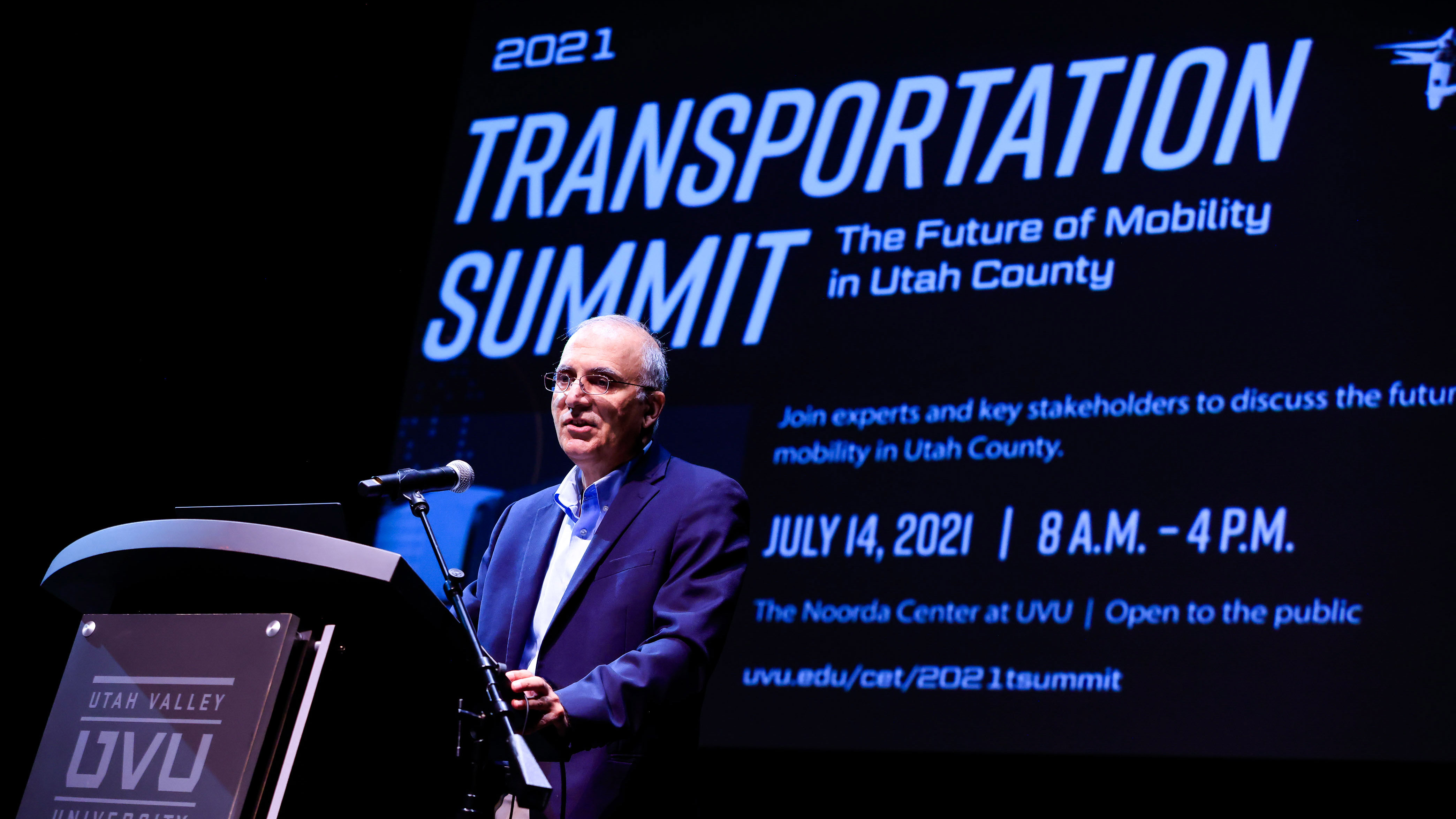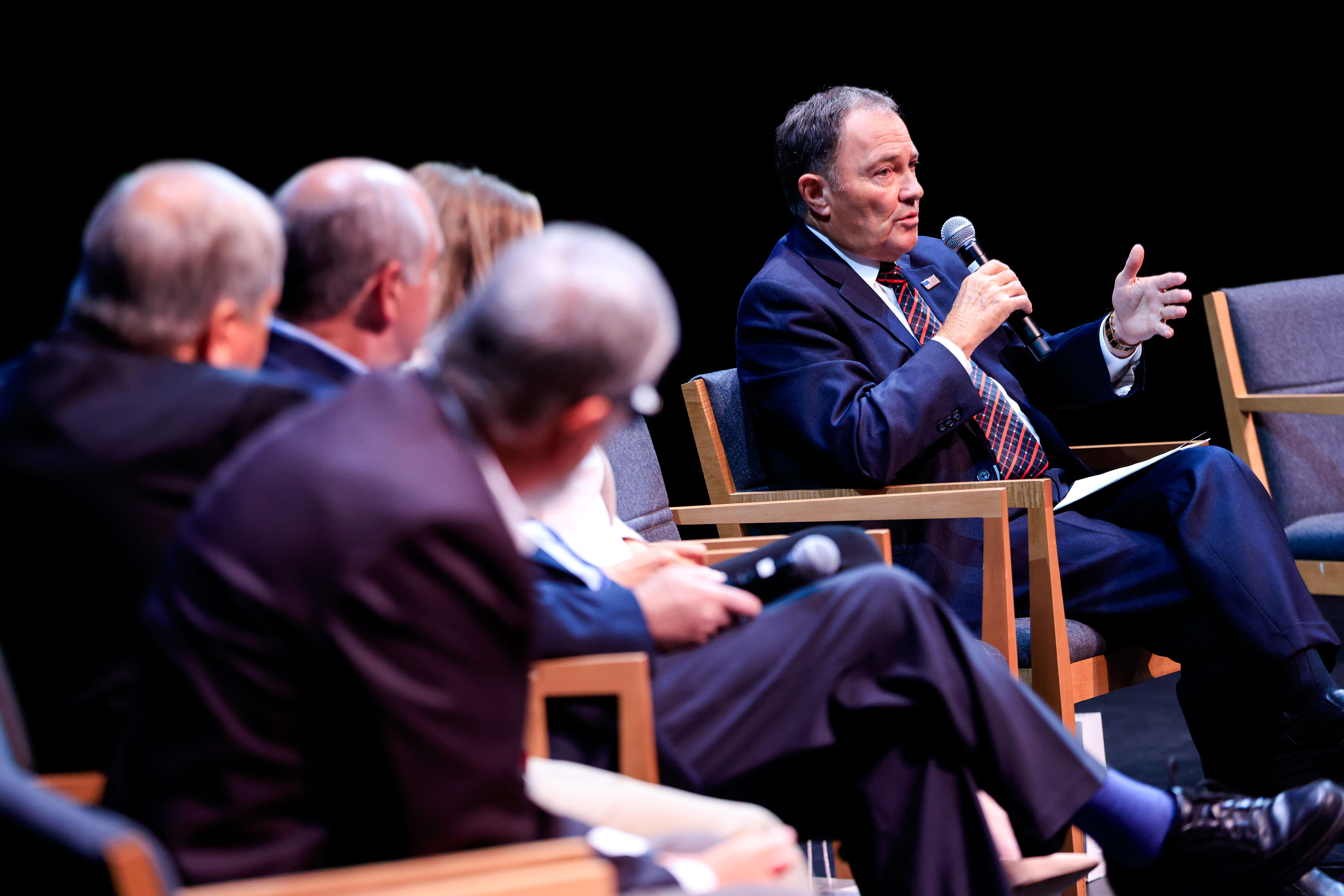The future of transportation in Utah and the accompanying economic development was the highlight of the 2021 Utah Transportation Summit hosted by UVU and BYU.

The future of transportation in Utah and the accompanying economic development was the highlight of the 2021 Utah Transportation Summit hosted by UVU and BYU. Government officials, experts, and the general public attended the event at the UVU Noorda Center for the Performing Arts on July 14. The summit was also livestreamed.
The purpose of this event was to bring together transportation experts and local government leaders to determine the future of transportation in the state and how to strategically plan for continued growth that will exacerbate the issue.
The summit began with the mayor’s panel at 8:30 a.m. where Mayor Richard Brunst (Orem), Mayor Mark Johnson (Lehi), Mayor Julie Fullmer (Vineyard), and Chief Administrative Officer Wayne Parker (Provo) gave short presentations on transportation issues in Utah County. UVU President Astrid S. Tuminez gave opening remarks reflecting on her time as a resident of Singapore and how Utah County should model their infrastructure after the city.
“In Singapore, they create magic with their infrastructure. It all happens by planning and design. We need to bring our best transportation ideas together and make magic happen,” Tuminez said. “We need to make Utah County livable for those coming behind us.”
Former Utah Governor Gary Herbert introduced the panel giving his own thoughts on staying on top of transportation issues.
“You need to build roads before people live in an area. We need to be ahead of the growth. We need to envision and look to the long term. We have one shot to get this right,” Herbert said.
According to Mayor Brunst, the population of Utah County will double within 40 or 50 years. He also mentioned that a bridge across Utah Lake from Saratoga Springs to Provo is in the plans for the future. His remarks heavily featured the process of funding transportation needs, and Brunst outlined the need for public officials to band together to solve transportation issues.
“We need better connectivity and a transportation grid in the future,” he said.
Mayor Fullmer outlined the strides that Vineyard is taking to address transportation needs in Utah, including thinking of ways to help Utahns adapt to walking by adding plazas, sidewalks, and housing. Additionally, Vineyard is planning for drone landing spots, Bluetooth, Wi-Fi, and smart technology.
At 11 a.m., the Utah Governor’s Office of Economic Development panel took the stage with panelists Benjamin Hart (Utah GOED), Vic Hockett (Talent Ready Utah), and Lance Soffe (Go Utah). This panel discussed how the governor's office is handling growth in Utah and aligning education programs to meet industry needs.
“We have done research over the last two decades and determined that five industries always rise to the top: aerospace and defense, financial services, information technology, life sciences, and advanced manufacturing — and we focus our resources on these industries, which brings up every other industry,” said Soffe.

Former Utah Gov. Gary R. Herbert speaks at the 2021 Utah Transportation Summit hosted by UVU and BYU.
The aviation panel that took place at 1 p.m. consisted of Jeff Carlson (AECOM), Jared Esselman (UDOT), Steve Gleason (Provo Airport), Brad Hayden (Robotic Skies), Adam Robertson (FORTEM Technologies), Andrew Scanlon (Kimley-Horn), and Bill Wyatt (Salt Lake International Airport). This panel focused on urban air mobility and accommodating those needs in the future.
“When we think of transportation in three dimensions, we start to think of traffic circles as traffic spheres — and bottlenecks are eliminated,” Esselman said.
Aerial corridors, terminal developments, and drone delivery were discussed by the other panelists.
The final panel was the UDOT, UTA, WFRC, and MAG panel at 2:30 p.m. Mary DeLoretto (UTA), Hal Johnson (UTA), Ted Knowlton (WFRC), Blaine Leonard (UDOT), and Shawn Seager (MAG) were the featured panelists.
According to Deloretto, UTA received $330 million from the state legislature for transit projects this year. Those projects include double-tracking the FrontRunner commuter rail system, a rail station in Vineyard, construction of streetcar facilities in Salt Lake City, bus rapid transit, a railroad consolidation project in Utah County, and an environmental study.
Leonard included six trends dominating transportation: demographic shifts, availability of data, mobility as a service, changes of vehicle propulsion, connected vehicles, and automated vehicles.
The overall message from all the panelists was that the state is growing and, in order to meet those needs, public officials need to collaborate with the appropriate entities and think strategically to meet the transportation needs of the future.